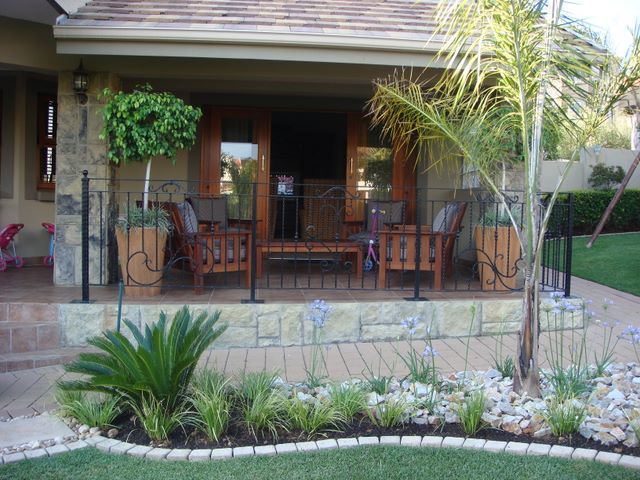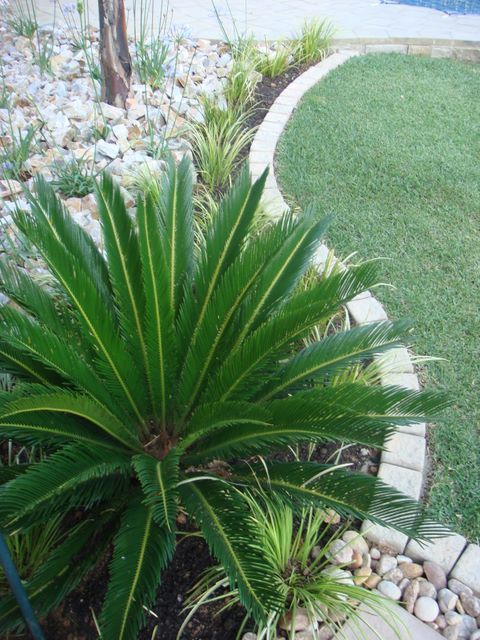Landscape Architecture for Landscape Architects › Forums › DETAILS & MATERIALS › Steel Edging
- This topic has 1 reply, 12 voices, and was last updated 7 years, 12 months ago by
 Andrew Garulay, RLA.
Andrew Garulay, RLA.
-
AuthorPosts
-
June 5, 2012 at 7:59 pm #157333
 KimberlyParticipant
KimberlyParticipantHi everyone,
I recently started working for a design/build firm in Southern Arizona. The company does fairly standard landscapes (although the best quality in the region), but I am hoping to help them branch out in to more creative and modern design if the right clients arise. My boss has told me on several occasions that he does not like using steel edging and will always try to talk a customer out of it. He says that it is dangerous and doesn’t want to deal with someone cutting their foot on it.
Well, I recently acquired a design job in which the customers want a more modern feel. I love the clean look of steel edging and want to use it to border the turf area. (I interned for Christy Ten Eyck for a while and LOVE the way she uses it in the landscape). I’m trying to figure out how to approach the situation. What I am wondering from you all more experienced is:
A) Does it really pose a danger?
B) Are there any clean looking alternatives?
C) If those of you who are experienced using steel edging recommend it, any ideas on how to approach my boss?
Thanks so much for your help!
Kim
June 5, 2012 at 11:39 pm #157355 Andrew Garulay, RLAParticipant
Andrew Garulay, RLAParticipant1. no
2. yes, alluminun
3. I would recommend it
Your boss probably finds that it is more difficult than other alternatives. The answer is to charge enough to make up for the difficulty and let the client decide not to do it instead of deciding not to do it for the client. Your boss wins either way.
June 6, 2012 at 12:46 am #157354 KimberlyParticipant
KimberlyParticipantThank you! Yes, I agree that the client should be the one to decide based on what they want. Hopefully, I can talk my boss into installing it if the client wants that.
June 6, 2012 at 5:06 am #157353 Jason T. RadiceParticipant
Jason T. RadiceParticipantA lot of people’s aprehension comes from using the really old stuff which never really anchored well and would eventually work loose. They were probably also using residential-grade, which is much, much thinner. If you use a good quality THICK commercial edging that has a proper fastening system, you will be just fine. Aluminum is a good alernative, but will not get the rusty patina, if that is the look you are after. I usually got for aluminum to prevent corrosion from deicing salts at the connection points (I use it on top of concrete and fastened with TAPCONs for unit paver restraints)
June 6, 2012 at 1:32 pm #157352 KimberlyParticipant
KimberlyParticipantThanks so much! Great advice. Do you have any recommendations on suppliers? How thick would you go, 12ga? I’m in the desert southwest, so many people use the rusted steel here.
June 6, 2012 at 4:26 pm #157351Anonymous
InactiveI used to spec a lot of steel edging when I first entered the profession. The common thought was that it helped keep turf from migrating into the bed areas. This has not been the case in my experience, it seems like the grass rhizomes just spreads right past it. Then I rationalized using it because it acts as a more permanent marker to define the bed areas. But, when a landscaper told me a story about a kid getting a nasty cut from falling on rusty widely spaced joint in the edging I stopped using it unless the client demanded it. That said, the last time I used it I called for the thick stuff and had them weld the joints and grind the sharp edges down to avoid this problem. Every two or three years a couple of sections need to be reinstalled because of frost heave, but it’s no big deal. If you have a client that insist that you use steel edging make sure you make it clear that ongoing maintenance may be required to avoid possible hazardous conditions (note this on the drawings).
I still pretty much don’t use the stuff. It’s a pain in the butt on curving slopes and undulating grades. Most importantly I think a bed that’s professionally deep edged in the spring and maintained with a steel edged trimmer during the growing season looks soooooooo much better. Besides most of the time the plants ultimately decide what the bed edge will be. I like to be able to move the edge as a garden matures or more plantings are added.
To be fair I may be a little biased against steel edging because I was probably traumatized as a young LA by my uncle who always asked for my garden advice, but never followed it. I sketched and labeled a foundation planting plan for him and told him exactly what to do to give his house some “curb appeal” and to call me if he had any questions. A couple of months had passed and I stopped by to see him and his wife for something totally unrelated. I almost passed out when I saw his place; he had sheared this gorgeous Japanese Maple that was planted about 30 years ago into a neat gumball shape and used white marble chips for mulch instead of the aged shredded hardwood mulch that I told him to use. Once my eyes adjusted from the glare of the marble chips I could see he was using green steel edging that was sticking up 6” out of the ground like a little curvilinear retaining wall. He was so proud of his work I couldn’t bring myself to tell him just how disgusted I really was. My uncle is no longer with us, but his steel edging which is now sticking 10” out of the ground and marble chips live on. Anyway who cares what a fancy college boy landscaper has to say about anything.
June 6, 2012 at 5:47 pm #157350 Jordan LockmanParticipant
Jordan LockmanParticipantA.It can pose a danger is not maintained. If it is damaged by a lawn mower or is heaved out of the ground. It will cut instead of crushing like plastic edging.
B. Alternatives, I like concrete bullets if installed correctly. Also there is a vinyl edging that looks like the steel. Designed so you do not see the bead on top of the grass. Also aluminum works and can cut kids feet too, but is not going to rust and is easier to work with.
C. I had a similar situation in a previous job where I wanted to use a different edging. I did all the research and pitched it to the boss with costs and availability. We did not use the edging, but it was at least talked about. I think that if you have a specific project that you want to use it on. Sell that to your boss and say that this product is perfect for the xxx project and will bring in $$$$ is we use it.
June 6, 2012 at 5:50 pm #157349 Jordan LockmanParticipant
Jordan LockmanParticipantAnother edge I always wanted to try is vinyl paver patio edging. If installed deep enough can give you a similar look.
June 6, 2012 at 7:26 pm #157348 KimberlyParticipant
KimberlyParticipantHi Jordan. Thanks for the advice! I really appreciate it. Can you tell me a little more about what the concrete bullets are? I talked to my boss again today and he suggested a concrete edge that is finished a little bit below the gravel. This is for another situation where the client wants dry set flagstone in an area that abuts the turf, but doesn’t want the turf to encroach on the flagstone area. They actually want to plant small ground covers between the flagstone. The problem is, out here in Arizona we have bermuda grass which is much more voracious at spreading that grasses in more temperate climates. I think that an edged bed without any sort of border would just spread like crazy out here. Maybe I am wrong?
June 6, 2012 at 8:46 pm #157347Anonymous
InactiveLOL I guess my suggestion and long a$$ story gotta big…meh!
I’ve done landscapes in Texas using 419 Tifway to St. Augustine and projects in Kansas, Ohio, Florida, New York and Connecticut using all kinds of Blue Grass and Fescue to Zoysia. Steel edging might retard growth for a while, but without maintenance the turf will always invade the beds—well at least where I’ve practiced it has. Maybe grass does something different in your parts.
Anyway I was going to suggest concrete edging, but not the kind that’s extruded from a machine because that stuff cracks up like crazy in a cold climate. On commercial projects I’ve used concrete edging with carefully placed expansion and control joints on the curved sections, this was back in the early nineties and they have held up well. But, that’s if you want that kind of look on your project. Like I said, I did it in the early nineties; do you know/remember what people dressed like back then?
No dis to edging users, but I’d never sacrifice safety to make such minor design statement. But you best believe if I were to use steel edging it would have an urban/industrial flavor to it. Like welding two pieces of salvaged Ryerson steel edging together and distressing it in a funky way. Or smooth graceful curves using ½ thick steel. Go big or go home. Otherwise stick with the classic deep edged bed practiced by gardeners for the longest. Deep edge in the spring, along with a couple of passes with a wheeled lawn edger during the growing season and it usually holds up with bi-weekly touch ups with a string trimmer with a steel blade. I think this is a case of less is more. No law suits for the firm and save the client on materials and labor.
June 6, 2012 at 10:48 pm #157346Anonymous
InactiveThe last time I spec-ed steel edging I think I was probably wearing acid washed jeans and loafers with no socks on—yuck no thanks. I also designed massive annual color beds and oversized pool terraces back then, it’s what we did. Now I’m glad the recession put an end to the tricked out outdoor kitchen/entertainment areas with the tvs and wine chillers and that kind of crap.
I said all that to say that, we as designers have to really think about the materials and landscape “stuff” we steer our clients toward. After a while you learn about all the bs people don’t need and the landscape gimmicks. Using steel edging does not mean that someone isn’t going to have to pull grass out of the planting beds, that’s a myth like weed barrier doesn’t keep weeds from establishing in beds. If we as professional landscape architects and designers continue to perpetuate foolishness like putting gravel into tree pits to improve drainage and the spreading of layers of unnecessary mulch every spring on our client’s properties, then we’re no better than the plant and product pushing landscapers. Let’s stop the madness steel edging in most cases does not do the job.
And please no more plastic or vinyl anything in our landscapes. I tell my clients if they’re on a limited budget to save their money up until they can afford a cedar fence and deck. Closing a PVC gate or leaning against a plastic rail it’s just not the same, in fact it takes away from the whole garden experience. My rule of thumb is if people can touch it, it has to be real wood, wrought iron, stone, steel or concrete finished to look like concrete.
Rant complete.
June 8, 2012 at 7:00 pm #157345 Craig de NeckerParticipant
Craig de NeckerParticipantHi there,
An alternative could be cobblestone edging – we have a huge demand for this kind of edging. For a more contemporary look, you could use a cobble with cleaner lines,or perhaps granite cobbles… here’s an example using a 100 x 100mm cobblestone set in concrete… it’s not as clean as steel, but there are some manufacturers with narrower, less obvious versions and of course a darker color will not stand out as much…
June 8, 2012 at 10:02 pm #157344mark foster
ParticipantSteel does provide those nice clean sharp curves on a budget like nothing else can. I think it has a place in certain applications, and we have used it many times.
Most manufacturers have more options than you may realize. There are a variety of gauges Some offer longer stakes. Some make it wider (6″ vs. 4″). All of which will give it more stability in the ground.
Always buy about 10% more stakes than the math tells you to. Always get the 16′ lengths vs. the 8 or 10′ lengths– the little extra money for the freight will be saved in installation and it will look cleaner
Weight, and thus freight, is a big issue with this product so look close to home. Make sure your crews take something to file the edges after they cut–a saw or grinder will leave some nasty sharp edges.
June 13, 2012 at 7:29 pm #157343 KimberlyParticipant
KimberlyParticipantI didn’t mean to ignore your post and it was definitely a great help! Thanks for your detailed responses…I really appreciate the sharing of knowledge. I’ve just been so incredibly busy that I meant to respond and never got back to it. Life is a tad crazy right now.
I am definitely interested in trying the deep edge, but I just don’t know how the Bermuda grass handles it out here and my boss said he doesn’t like leaving off some sort of barrier. No doubt, with Rhizomes 2 feet deep, the Bermuda is bound to spread with a border or not, but a border seems to keep the maintenance down a bit more for the client. That being said, I’m just not a huge fan of having any border around grass, which is why I like the look of steel because it is very clean. However, I do want safety to come first and since I don’t have a lot of practical experience, I’m glad to get all your feedback. It sounds like there are some safety issues and that it probably isn’t the best solution for my current application.
Thanks for all the awesome suggestions! I’m with you on the “Go Big or Go Home.” Unfortunately the design build clients aren’t always in that same mindset. I’d love it of there were.
June 13, 2012 at 7:29 pm #157342 KimberlyParticipant
KimberlyParticipantVery pretty! Thanks for sharing! Anyone else have some pictures of borders from their own projects? I would love to see…
-
AuthorPosts
- You must be logged in to reply to this topic.



